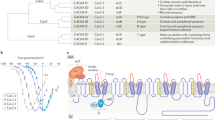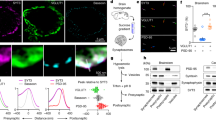Abstract
In many neurons, subthreshold somatic depolarization can spread electrotonically into the axon and modulate subsequent spike-evoked transmission. Although release probability is regulated by intracellular Ca2+, the Ca2+ dependence of this modulatory mechanism has been debated. Using paired recordings from synaptically connected molecular layer interneurons (MLIs) of the rat cerebellum, we observed Ca2+-mediated strengthening of release following brief subthreshold depolarization of the soma. Two-photon microscopy revealed that, at the axon, somatic depolarization evoked Ca2+ influx through voltage-sensitive Ca2+ channels and facilitated spike-evoked Ca2+ entry. Exogenous Ca2+ buffering diminished these Ca2+ transients and eliminated the strengthening of release. Axonal Ca2+ entry elicited by subthreshold somatic depolarization also triggered asynchronous transmission that may deplete vesicle availability and thereby temper release strengthening. In this cerebellar circuit, activity-dependent presynaptic plasticity depends on Ca2+ elevations resulting from both sub- and suprathreshold electrical activity initiated at the soma.
This is a preview of subscription content, access via your institution
Access options
Subscribe to this journal
Receive 12 print issues and online access
$209.00 per year
only $17.42 per issue
Buy this article
- Purchase on Springer Link
- Instant access to full article PDF
Prices may be subject to local taxes which are calculated during checkout







Similar content being viewed by others
References
Alle, H. & Geiger, J.R.P. Combined analog and action potential coding in hippocampal mossy fibers. Science 311, 1290–1293 (2006).
Shu, Y., Hasenstaub, A., Duque, A., Yu, Y. & McCormick, D.A. Modulation of intracortical synaptic potentials by presynaptic somatic membrane potential. Nature 441, 761–765 (2006).
Kole, M.H.P., Letzkus, J.J. & Stuart, G.J. Axon initial segment Kv1 channels control action potential waveform and synaptic efficacy. Neuron 55, 633–647 (2007).
Bollmann, J.H., Sakmann, B. & Borst, J.G.G. Calcium sensitivity of a glutamate release in a calyx-type terminal. Science 289, 953–957 (2000).
Schneggenburger, R. & Neher, E. Intracellular calcium dependence of transmitter release rates at a fast synapse. Nature 406, 889–893 (2000).
Zucker, R.S. & Regehr, W.G. Short-term synaptic plasticity. Annu. Rev. Physiol. 64, 355–405 (2002).
Sabatini, B.L. & Regehr, W.G. Control of neurotransmitter release by presynaptic waveform at the granule to Purkinje cell synapse. J. Neurosci. 17, 3425–3435 (1997).
Borst, J.G.G. & Sakmann, B. Calcium influx and transmitter release in a fast CNS synapse. Nature 383, 431–434 (1996).
Bischofberger, J., Geiger, J.R. & Jonas, P. Timing and efficacy of Ca2+ channel activation in hippocampal mossy fiber boutons. J. Neurosci. 22, 10593–10602 (2002).
Brenowitz, S.D. & Regehr, W.G. Reliability and heterogeneity of calcium signaling at single presynaptic boutons of cerebellar granule cells. J. Neurosci. 27, 7888–7898 (2007).
Awatramani, G.B., Price, G.D. & Trussell, L.O. Modulation of transmitter release by presynaptic resting potential and background calcium levels. Neuron 48, 109–121 (2005).
Hori, T. & Takahashi, T. Mechanisms underlying short-term modulation of transmitter release by presynaptic depolarization. J. Physiol. (Lond.) 587, 2987–3000 (2009).
Scott, R., Ruiz, A., Henneberger, C., Kullmann, D.M. & Rusakov, D.A. Analog modulation of mossy fiber transmission is uncoupled from changes in presynaptic Ca2+. J. Neurosci. 28, 7765–7773 (2008).
Trigo, F.F. et al. Presynaptic miniature Gabaergic currents in developing interneurons. Neuron 66, 235–247 (2010).
Palay, S.L. & Chan-Palay, V. Cerebellar Cortex: Cytology and Organization (Springer-Verlag, New York, 1974).
Mejia-Gervacio, S. et al. Axonal speeding: shaping synaptic potentials in small neurons by the axonal membrane compartment. Neuron 53, 843–855 (2007).
Glitsch, M. & Marty, A. Presynaptic effects of NMDA in cerebellar Purkinje cells and interneurons. J. Neurosci. 19, 511–519 (1999).
Christie, J.M. & Jahr, C.E. Dendritic NMDA receptors activate axonal calcium channels. Neuron 60, 298–307 (2008).
Vincent, P. & Marty, A. Fluctuations of inhibitory postsynaptic currents in Purkinje cells from rat cerebellar slices. J. Physiol. (Lond.) 494, 183–199 (1996).
Diana, M.A. & Marty, A. Characterization of depolarization-induced suppression of inhibition using paired interneuron–Purkinje cell recordings. J. Neurosci. 23, 5906–5918 (2003).
Llano, I., Tan, Y.P. & Caputo, C. Spatial heterogeneity of intracellular Ca2+ signals in axons of basket cells from the rat cerebellar slices. J. Physiol. (Lond.) 502, 509–519 (1997).
Forti, L., Pouzat, C. & Llano, I. Action potential–evoked Ca2+ signals and calcium channels in the axons of developing cerebellar interneurons. J. Physiol. (Lond.) 527, 33–48 (2000).
Tottene, A., Moretti, A. & Pietrobon, D. Functional diversity of P-type and R-type calcium channels in rat cerebellar neurons. J. Neurosci. 16, 6353–6363 (1996).
Metz, A.E., Jarsky, T., Martina, M. & Spruston, N. R-type calcium channels contribute to afterdepolarization and bursting in hippocampal CA1 pyramidal neurons. J. Neurosci. 25, 5763–5773 (2005).
Borst, J.G.G. & Sakmann, B. Facilitation of presynaptic calcium currents in the rat brainstem. J. Physiol. (Lond.) 513, 149–155 (1998).
Cuttle, M.F., Tsujimoto, T., Forsythe, I.D. & Takahashi, T. Facilitation of the presynaptic calcium current at an auditory synapse in the rat brainstem. J. Physiol. (Lond.) 512, 723–729 (1998).
Atluri, P.P. & Regehr, W.G. Determinants of the time course of facilitation at the granule cell to Purkinje cell synapse. J. Neurosci. 16, 5661–5671 (1996).
Bucurenciu, I., Kulik, A., Schwaller, B., Frotscher, M. & Jonas, P. Nanodomain coupling between Ca2+ channels and Ca2+ sensors promotes fast and efficient transmitter release at a cortical GABAergic synapse. Neuron 57, 536–545 (2008).
Bucurenciu, I., Bischofberger, J. & Jonas, P. A small number of open Ca2+ channels trigger transmitter release at a central GABAergic synapse. Nat. Neurosci. 13, 19–21 (2010).
Dittman, J.S., Kreitzer, A.C. & Regehr, W.G. Interplay between facilitation, depression, and residual calcium at three presynaptic terminals. J. Neurosci. 20, 1374–1385 (2000).
Müller, M., Goutman, J.D., Kochubey, O. & Schneggenburger, R. Interaction between facilitation and depression at a large CNS synapse reveals mechanisms of short-term plasticity. J. Neurosci. 30, 2007–2016 (2010).
Atluri, P.P. & Regehr, W.G. Delayed release of neurotransmitter from cerebellar granule cells. J. Neurosci. 18, 8214–8227 (1998).
Lu, T. & Trussell, L.O. Inhibitory transmission mediated by asynchronous transmitter release. Neuron 26, 683–694 (2000).
Otsu, Y. et al. Competition between phasic and synchronous release for recovered synaptic vesicles at developing hippocampal autaptic synapses. J. Neurosci. 24, 420–433 (2004).
Christie, J.M. & Jahr, C.E. Selective expression of ligand-gated ion channels in L5 pyramidal cell axons. J. Neurosci. 29, 11441–11450 (2009).
Li, L., Bischofberger, J. & Jonas, P. Differential gating and recruitment of P/Q-, N-, and R-type Ca2+ channels in hippocampal mossy fiber boutons. J. Neurosci. 27, 13420–13429 (2007).
Wu, L.-G., Borst, J.G.G. & Sakmann, B. R-type Ca2+ currents evoke transmitter release at a rat central synapse. Proc. Natl. Acad. Sci. USA 95, 4720–4725 (1998).
Llano, I. et al. Presynaptic calcium stores underlie large-amplitude miniature IPSCs and spontaneous calcium transients. Nat. Neurosci. 3, 1256–1265 (2000).
Tsujimoto, T., Jeromin, A., Saitoh, N., Roder, J.C. & Takahashi, T. Neural calcium sensor 1 and activity-dependent facilitation of P/Q-type calcium currents at presynaptic nerve terminals. Science 295, 2276–2279 (2002).
Jinno, S., Jeromin, A., Roder, J. & Kosaka, T. Immunocytochemical localization of neural calcium sensor 1 in the hippocampus and cerebellum of the mouse, with special reference to presynaptic terminals. Neuroscience 113, 449–461 (2002).
Jinno, S., Jeromin, A. & Kasaka, T. Expression and possible role of neuronal calcium sensor-1 in the cerebellum. Cerebellum 3, 83–88 (2004).
Geiger, J.R.P. & Jonas, P. Dynamic control of presynaptic Ca2+ inflow by fast-inactivating K+ channels in hippocampal mossy fiber boutons. Neuron 28, 927–939 (2000).
Turecek, R. & Trussell, L.O. Presynaptic glycine receptors enhance transmitter release at a mammalian central synapse. Nature 411, 587–590 (2001).
Felmy, F., Neher, E. & Schneggenburger, R. Probing the intracellular calcium sensitivity of transmitter release during synaptic facilitation. Neuron 37, 801–811 (2003).
Müller, M., Felmy, F. & Schneggenburger, R. A limited contribution of Ca2+ current facilitation to paired-pulse facilitation of transmitter release at the rat calyx of Held. J. Physiol. (Lond.) 586, 5503–5520 (2008).
Tang, Y., Schlumpberger, T., Kim, T., Lueker, M. & Zucker, R.S. Effects of mobile buffers on facilitation: experimental and computational studies. Biophys. J. 78, 2735–2751 (2000).
Heidelberger, R., Heinemann, C., Neher, E. & Matthews, G. Calcium dependence of the rate of exocytosis in a synaptic terminal. Nature 371, 513–515 (1994).
Wu, L.-G. & Borst, J.G.G. The reduced release probability of releasable vesicles during recovery from short-term synaptic depression. Neuron 23, 821–832 (1999).
Dodt, H.U., Eder, M., Schierloh, A. & Zieglgansberger, W. Infrared-guided laser stimulation of neurons in brain slices. Sci. STKE 120, 12 (2002).
Rae, J., Cooper, K., Gates, P. & Watsky, M. Low access resistance perforated patch recordings using amphotericin B. J. Neurosci. Methods 37, 15–26 (1991).
Acknowledgements
We thank M. Herman, M. McGinley, B. Nahir and J. Pugh for their helpful discussions and comments on the manuscript. This work was supported by US National Institutes of Health grant NS066037 (C.E.J.).
Author information
Authors and Affiliations
Contributions
Each of the authors contributed extensively to the design and implementation of the experiments, interpretation of the data and writing of the manuscript.
Corresponding author
Ethics declarations
Competing interests
The authors declare no competing financial interests.
Supplementary information
Supplementary Text and Figures
Supplementary Figure 1 (PDF 325 kb)
Rights and permissions
About this article
Cite this article
Christie, J., Chiu, D. & Jahr, C. Ca2+-dependent enhancement of release by subthreshold somatic depolarization. Nat Neurosci 14, 62–68 (2011). https://doi.org/10.1038/nn.2718
Received:
Accepted:
Published:
Issue Date:
DOI: https://doi.org/10.1038/nn.2718
This article is cited by
-
Background calcium induced by subthreshold depolarization modifies homosynaptic facilitation at a synapse in Aplysia
Scientific Reports (2020)
-
Monitoring intracellular nanomolar calcium using fluorescence lifetime imaging
Nature Protocols (2018)
-
Toward Analog Neural Computation
Minds and Machines (2018)
-
Analogue modulation of back-propagating action potentials enables dendritic hybrid signalling
Nature Communications (2016)
-
Postsynaptic, not presynaptic NMDA receptors are required for spike-timing-dependent LTD induction
Nature Neuroscience (2016)



